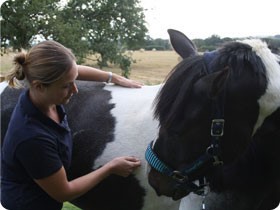Manual Therapy and Massage for Horses and Large Animals
Massage, stretching, and gentle skeletal realignment are all highly effective therapies in managing animal injury and rehabilitation. They may be employed as standalone treatments, or in conjunction with electrotherapies and remedial exercise prescription.
Massage

The benefits of massage are well documented, from effecting the removal of localised toxin build-up resulting from a hypoxic environment caused by muscular contracture, through to producing an increase in blood flow, tissue elasticity and local thermal effects which accelerate tissue recovery.
Differing massage techniques produce differing effects on the underlying tissues;
- Effleurage massage addresses muscle tension and can aid oedemic drainage. This technique can be easily taught to the owner and reproduced therapeutically on a daily basis without the need for therapist presence.
- Petrissage massage will increase muscle tone, and is advocated to areas of muscle loss.
- Tapotement massage increased localised blood flow.
- Localised friction massage can be used to address post surgical adhesions and scar tissue bonds.
Trigger Point and Myofascial Release
Localised trigger points were first identified by Travell and Simons (1993), and correspond to areas of myofascial pain syndrome resulting from pathology in joints, viscera and nervous system. These points clinically produce pain on compression and in a referred pattern, and most importantly in addressing postural compensations, restrict movement by altering the pattern of muscular activation in muscle groups. Deactivation of trigger points can be achieved through massage techniques. Applying soft tissue myofascial release techniques removes fascial tethering which can also hinder correct posture and locomotion.
Passive Range of Motion Stretches

Permanent soft tissue contracture can result from a reduction in joint movement over a period of time. In adopting a posture which seeks to limit movement to mitigate pain, a shortening of both the soft tissues immediately surrounding this area can occur, but importantly, a secondary shortening may occur in other areas such as synergistic flexors and extensors of the limb. Passive range of movement stretches can serve to correct these contractures, and restore full range of movement. Lateral, ventral and ventro-lateral head and neck stretches can ensure correct recruitment of dorsal and ventral muscle chains, resulting in improved posture and core strength.
Stretching improves elasticity of collagenous structures, as these tissue components change microscopically in response to the stretch stimulus, and fibres of muscle elongate through the serial recruitment of new sarcomeres to the end of existing myofibrils.
To learn more about our equine services or to book an appointment please contact us




